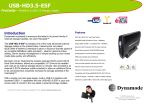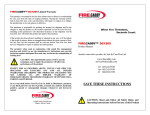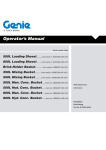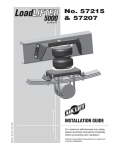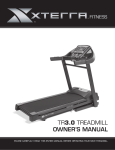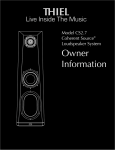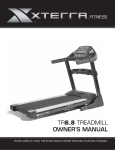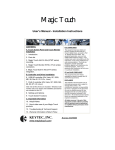Download SAVE THESE INSTRUCTIONS
Transcript
Contents When Fire Threatens, Seconds Count. FIRECADDY™ GH5501 Product Manual Another innovative product by Just-In Case Fire Ltd. www.firecaddy.com [email protected] tel: 403.243.9728 fax: 403.243.9749 tf: 866.652.2339 Requirements for Safe Operation …………………..……………....………. 3 the FireCaddy GH5501 ……………………………..………………..…...… 5 Basic Firefighting Principles ………………………………………..……… 5 All Figures …………………………………………………………...…….... 6 Fig. 1 the FireCaddy GH5501 Fig. 2 the Control Panel Fig. 3 Rear View Fig. 4 Front View Fig. 5 the Engine Operating your FireCaddy ………………………………………...…….. 7 - 10 Preparations for First Use Starting the FireCaddy Shutting Down the FireCaddy Settings for Fire Suppression Operation Winter / Cold Weather Operation Trouble Shooting ……………………………………………..……..........… 11 Low Pressure Maintenance and Regular Test Operation ……………..……..…………..… 12 FireCaddy Maintenance Schedule ……………………………..…............… 13 Appendices ………………………………………………….....................… 14 Settings for NON Fire Suppression Operation Use of Secondary Discharge Ports Fire Caddy Specifications ……..………………………………...............….. 15 Honda Engine System and Pump Fire Caddy Limited Warranty ……..……………………………....….....….. 16 Fire Caddy™ and Just-In Case Fire™ are Trade Marks of Just-In Case Fire Ltd., Calgary, Alberta, Canada. SAVE THESE INSTRUCTIONS FlameOut® is a registered Trade Mark of Summit Environmental Corporation, San Diego, CA, USA. FlameOut® is the only wetting agent recommended to be used by both the FDA and the EPA. FlameOut® is a certified replacement for Halon 1211 by the US-EPA. FlameOut® is UL listed (#7P21) for Class A & B fires. CAUTION: Read and follow all Safety Rules & Operating Instructions before first use of this Product © 2007 Just-In Case Fire Ltd. Calgary, Alberta, Canada 2 CAUTION: Carefully read all sections of this user manual before using your new Fire Caddy. Pay close attention to all CAUTIONS, Warnings, Instructions for Operation, Procedures and Maintenance. The Fire Caddy must be regularly maintained and test operated in order to be available when needed. The FireCaddy is only rated for use on Class A and Class B fires ONLY. O RDI NA RY A Ordinary combustibles such as wood, cloth, paper, and rubber. COM BUSTI B LES FAILURE TO COMPLY WITH ALL CAUTIONS, WARNINGS, INSTRUCTIONS, PROCEDURES AND MAINTENANCE MAY RESULT IN SERIOUS INJURY OR DEATH &/OR LOSS OR DAMAGE TO PROPERTY. WARRANTY: A limited, one-year warranty is provided by the manufacturer of your FireCaddy. The details are provided on the back cover of this product manual. By registering your product, you agree to allow the manufacturer to contact you with critical updates and information for you to continue safe operating practices. Notices cannot be made if you do not register your FireCaddy. This may void all warranties stated or implied. Promptly register each FireCaddy by serial number at: www.firecaddy.com/products/warrantyreg F LA MM AB LE B Ordinary flammable or combustible liquids, flammable gases, greases and similar materials such as gasoline, oil, paint and natural and propane gases. LIQ UI DS Open wiring and electrical appliances may have energized electrical sources. E LE CTRICA L C The FireCaddy is NOT rated for Electrical Fires. Do NOT use the Fire Caddy in the presence of energized electrical equipment. E QUIPM E NT Other safe practices and sensible precautions: Keep children and observers away from the Fire Caddy during operation. Do not force the Fire Caddy, it will do the job better and safer at the rate and capability for which it was designed. Wear protective hair covering to contain long hair and keep it from being drawn into the Fire Caddy during operation. Do not overreach, keep proper footing and balance at all times during operation. FireCaddy serial number Failure to maintain the FireCaddy and to test operate on a regular basis may void all warranties stated or implied. REQUIREMENTS FOR SAFE OPERATIONS Do NOT attempt to operate this device until you have read this manual thoroughly and understand completely all cautions, warnings, safety rules, operating instructions, procedures and maintenance procedures. Failure to comply can result in serious injury or death or loss and damage to property. Save the owners manual and review frequently for continued safe operation, and for instructing others who may use the FireCaddy. Avoid any dangerous situation where a threat of a fire or a fire exceeds your training & experience or the operating capabilities of the FireCaddy. Always position yourself to the fire so that there are multiple exit paths. continued next page…. 3 Stay alert, exercise control. Watch what you are doing and use common sense. Do not operate the Fire Caddy when you are tired, or under the influence of and drugs, medication or alcohol. Do not rush. Do not use the Fire Caddy if the switches, parts or controls do not operate properly or are damaged. Have the defective items repaired or replaced immediately. Always wear safety glasses. Maintain the Fire Caddy with care. Follow all instructions and inspect it regularly. Never operate the Fire Caddy without following these rules for safe operation and all the instructions for operation, procedures and maintenance as well as all and any cautions and warnings in this owner’s manual. 4 Fig. 2 Control Panel the FIRECADDY™ GH5501 1 The FireCaddy is a versatile self-contained fire suppression system that will protect your significant investments in your property. Use the Fire Caddy on acreages, farms, and cottages or for brush fires for the best in personal protection. For commercial applications use the Fire Caddy on construction sites, oil and gas operations, welding applications or anywhere supplemental fire suppression equipment is required. 2 2 1 Operating Pressure Gauge 2 Fire Suppressant Selector Fig. 3 Rear View The Fire Caddy fills the significant void between the fire extinguisher and the fire truck providing significant fire protection when used in conjunction with the manufacturer’s recommended procedures. Basic Firefighting Principles 1. CALL Local Fire Emergency Response (911 in North America): The Fire Caddy has been designed as a measure of protection from the time the fire department has been notified, until their arrival to mitigate the emergency. DO NOT PUT YOURSELF IN HARMS WAY WHILE TRYING TO EXTINGUISH A FIRE USING THE FIRE CADDY. Both Volunteer and Professional Firefighters have hundreds of hours in training, as well as proper Personal Protective Equipment (PPE). 2. Start the Fire Caddy: Using the operating instructions Starting the FireCaddy, ONLY IF IT IS SAFE TO DO SO. 3. Activate Fire Hose: The Fire Caddy is designed to be able to operate two separate hose lines simultaneously. To activate the pre-mounted 3/4 inch rubber hose, pull hose out and turn activation valve at the nozzle to the “open” position. To activate the 1 inch cotton jacket hose, stretch out hose to avoid kinks. Turn activation valve located on brass fitting located coming out of the pump assembly, to the “open” position. Turn activation valve on nozzle assembly to open (or forward position). NEVER APPROACH A FIRE WITHOUT TESTING THAT HOSELINES HAVE ADEQUATE WATER FLOW. Do this by opening the activation valves at the nozzle assembly for 3 to 4 seconds. This will get any air out of the lines. 4. Approach fire from the “upwind” side only: Fires give off superheated toxic fumes that can be harmful or even fatal if breathed in. Approaching from the upwind side reduces but does not eliminate the risk of exposure. To determine what the upwind side is, look at the direction that the smoke is going, and come in from opposite side. 5. Check for hazards: Before attacking a fire make sure that there are no hidden hazards (downed power lines, ruptured compressed gas tank etc.). Continued …. 5 1 FlameOut® mounted with Center Insert Upwards 3 1 Fire Operation Control Valve 2 ½” Auxilliary Discharge Port 3 Pump Inlet 6 1 2 Fig. 4 Front View View 1 2 3 1 Fire Operation Control Valve 2 1½” Secondary Discharge Port 4 5 Fig. 5 the Engine Fig. 1 FIRECADDY™ GH5501 1 2 3 4 5 6 6 ¾” High Pressure Hose Nozzle Control Panel Engine Run Switch Automatic Wheel Chocks 2-Position Handle 1 2 1 2 3 4 Throttle Choke Gas Flow Sw. Starter Rope 4 3 Procedure I cont’d…. iii Check the Secondary Pump Discharges and the Priming Port as shown in Fig. 3 ensuring that all connections are tight. iv. Open ANY other valves in the suction lines; ensure water is reaching the pump. v. As the water source is above the Pump Inlet of the pump a prime will automatically be provided to the pump. 5. cont’d… Be constantly aware of your surroundings, and adjust your attack accordingly. 6. Attack the Fire: Depending on the materials burning, there are two basic methods to attacking a fire. Class “A” Fires; Direct the foam directly at the seat of the fire. That is the base of the fire where the flames are starting. An aggressive initial attack will help in the suppression of a fire. The FlameOut® Firefighting foam is especially designed to eliminate two of the factors of the fire tetrahedron that is required for a fire to burn. Class “B” Fires; Are fought differently than class “A” fires. Do not aim the foam stream directly at the seat of the fire. This will actually push the flames to unburned areas creating a bigger fire by giving it more fuel to burn. Lob the foam on top of the flames creating a blanket that will smother the flames. Try and maintain the foam in one specific area allowing the suppression agents of the FlameOut®. Preparation for First Use Immediately upon delivery and prior to the first use of the FireCaddy the following procedures MUST be followed. Failure to perform these steps upon receiving your FireCaddy will invalidate your warranty and may render the FireCaddy unable to perform its intended operation. Serious injury or death &/or loss or damage to property may result. 1. Locate the enclosed user manual for the gasoline engine and follow all of the manufacturer’s instructions for preparation and the addition of the proper grades of gasoline and oil. 3. 4. Ensure that the Fire Suppressant Selector as shown in Fig. 2 is completely closed. 5. Un-spool a length of High Pressure Discharge Hose (Fig. 1) and point away from any structure or person. Note that it is not necessary to completely un-spool the red high pressure hose. 6. Ensure an adequate supply of water. 7. Start the Engine following the manufacturer’s recommended operation. 8. Open the control valve at the end of the high pressure hose. 9. Ensure the pumping of water and a high pressure discharge at the end of the hose. The Operating Pressure Gauge (Fig. 3) should show a pressure between 60 and 80 PSI. if not, please stop the engine and refer to the troubleshooting section of this manual. CAUTION - Do NOT start the engine at this time 2. Remove all tags and tie wraps. 3. Prime the pump. The pump can be primed by following one of the two procedures below. Select the procedure best suited for your purpose: Procedure I If the fire caddy is or will be connected to a permanent water source where the level of the water in the water source is higher than the inlet to the pump then use this procedure: i. Connect the supplied suction hose to the Pump Inlet as shown in Fig. 3. ii Ensure the Pump Drain Plug as shown in Fig. 3 is tightly closed. 7 Procedure II If the fire caddy is or will be connected to a pond, swimming pool, lake, river, stream or other low lying water source use this procedure: i. Ensure the Pump Drain Plug as shown in Fig. 3 is tightly closed. ii. Check the Secondary Pump Discharges as shown in Fig. 3 ensure that all connections are tight. iii. Ensure that the foot valve on the end of the suction hose is connected. Fill suction hose completely with water and connect to the Pump Inlet as shown in Fig. 3. iv. Open the Priming Port as shown in Fig. 3 and fill pump cavity completely with water. Replace the cap on the Priming Port and ensure a tight connection. v. Open ANY other valves in the suction lines and ensure water is reaching the pump. Ensure that the Fire Operation Control Valve as shown in Fig. 4 is closed. The closed position is perpendicular to the line. 10. Stop the engine. 11. Remove the center insert of the FlameOut® container. This is a punch out that can be removed with any sharp object or by pushing the inset inward 8 12. Install the suction line into the FlameOut® container and secure by screwing the fitting in place. Settings for Fire Suppression Operation These settings MUST be used on the FireCaddy when it is intended to be used as a fire suppressant device. The FireCaddy will NOT perform as required if it has not been configured properly. 13. Ensure that the Fire Operation Control Valve as shown in Fig. 4 is open. The open position is parallel (or inline to) to the tubes. 14. Open the Fire Suppressant Selector (Fig. 2) to a position in the green area. 15. Start the engine following the manufacturer’s procedures and see Starting the FireCaddy on this page. 1. 16. Ensure a supply of FlameOut® is discharged from the high pressure hose. FlameOut® will feel soapy to the touch and when discharged to a wall or structure will appear opaque in color and will adhere to the structure. Using the Fire Suppression Selector (Fig. 2), select the concentration of FlameOut® to use for the fire. Select a position in the green area of the valve motion for Class A fires and a position in the red area for Class B fires. If you are unsure of the type of fire, completely turn the Fire Suppressant Selector to the left-most stop ensuring the maximum flow of FlameOut® foam suppressant. 17. Rotate the Fire Suppressant Selector (Fig. 2) through all positions ensuring that FlameOut® is discharged at all positions. 2. Completely open the Fire Operation Control Valve (Fig. 4). 18. Stop the engine. See Shutting Down the FireCaddy on this page. 3. Ensure an adequate supply of water. 19. Completely close the Fire Suppressant Selector (Fig. 2). 4. Spool out a supply of High Pressure Hose (Fig. 1) and point away from any structure or person. Note that it is not necessary to completely unspool the ¾” high pressure rubber (red) hose. Starting the FireCaddy 5. Operate the pump as required. Point the nozzle at the base of the fire. Use a sweeping motion to apply the FlameOut foam/water mixture to the fire. 1. Turn Engine Run Switch (Fig. 5) to ON. This located on the right side of the motor as you face the front of the FireCaddy. 2. Turn the Choke ON. (see Fig. 5) 3. Ensure the Fuel is ON. This is the lower lever under the filter housing assembly which needs to be positioned to the right. 4. Pull the Starter Rope (Fig. 5). Brace the base of the FireCaddy with your foot, grasp the pull handle firmly and pull the rope outwards in a continuous, smooth motion. The Engine should start within 5 pulls. If not, repeat steps 1 thru 4. 5. Once the engine is running and is warm, slowly turn the Choke OFF. 6. Increase throttle to full. Do NOT continue to operate the pump after the FlameOut® container has been exhausted. At full volume flow rates of FlameOut®, this is approximately 14 minutes of operation. Replace the empty container and resume operating the FireCaddy. Winter / Cold Weather Operation WARNING: The FlameOut® fire suppressant will freeze at temperatures of -5ºC (22ºf). Do NOT allow FlameOut® to freeze to ensure the availability of foam suppressant during the event of fire. The efficiency of FlameOut® may be affected depending on severity of freezing. Shutting Down the FireCaddy Do NOT attempt to mix FlameOut® with any antifreeze product as it will negatively affect the performance of the product 1. Turn Throttle (Fig. 5) to IDLE. 2. Turn the Engine Run Switch (Fig. 1) OFF. 3. Once engine stops, turn Engine Run Switch back to ON, and leave in that position to be prepared for future use. 4. Turn the Fire Operation Control Valve (Fig. 4) to the OFF position. This will prevent the potential for FlameOut® to flow back into the water lines. 9 The water source may be mixed with a non-toxic antifreeze solution at a concentration that is recommended by the manufacturer of the antifreeze product for your climate conditions to ensure the availability of the water source for use in your FireCaddy. Refer to the engine manufacturer’s Operating Manual for requirements of cold climate operation 10 Troubleshooting Maintenance and Regular Test Operation Low Pressure The normal operating range of the FireCaddy is 60 PSI to 80 PSI. The operating pressure of the FireCaddy can be read from the Operating Pressure Gauge on the front panel. A low pressure condition can be caused by: 1. The gasoline powered engine may be running slower than the maximum speed (RPMs). a. Refer to the engine manufacturer’s operating instructions and ensure that the throttle is set to the maximum speed. 2. An air pocket exists in the suction hose of the Fire Caddy. a. Stop the FireCaddy. b. Ensure that the pump is correctly primed (refer to the operating instructions in this manual for priming the pump). c. Ensure that the suction hose is completely filled with water and that the foot valve is operating correctly. d. Re-start the engine and monitor the operating pressure of the FireCaddy. 3. An obstruction exists in the suction hose of the FireCaddy. a. Stop the FireCaddy. b. Remove the Suction Hose from the FireCaddy and visually inspect the entire length of the hose and the fitting and ensure that no obstruction exists. c. Remove the Secondary Discharge Port Covers on the FireCaddy and visually inspect that no obstruction exists. d. Remove the Discharge Hose from the pump and flush with water to remove any obstruction. e. Reconnect the Suction Hose to the FireCaddy. f. Re-start the engine and monitor the operating pressure of the FireCaddy. Each calendar month, for a total of twelve maintenance checks per year, perform the following regular maintenance activities. Select a time and date that is convenient and set a schedule for maintenance that will ensure this test cycle is adhere to and followed. Check the oil level of the gasoline engine. Follow the engine manufacturer’s recommended procedures for checking the oil level of the engine. 2. Check the level of gasoline in the tank. Ensure at all times that the gasoline level in the engine is at or near the maximum fill line. 3. Ensure an adequate supply of water. 4. Start the engine following the manufacturer’s recommendations. 5. Open the nozzle valve fully. 6. Ensure that the pressure is between 60 PSI and 80 PSI. If the pressure is not in this range stop the engine and refer to the troubleshooting section of this manual. 7. Open the Fire Suppressant Selector (Fig. 2) to a position in the green range and ensure that a supply of FlameOut® is being discharged from the nozzle. 8. Close the Fire Suppressant Selector (Fig. 2). 9. Stop the Engine following the manufacturer’s recommended practices. 10. Record the maintenance activity in the maintenance chart. A chart has been provided in this manual for recording the maintenance actions. If none of the troubleshooting actions resolves the low pressure problem with the FireCadday, immediately discontinue use of the FireCaddy and contact your FireCaddy Distributor or the manufacturer. Failure to comply with these instructions may result in serious injury or death &/or loss or damage to property. 11 1. Failure to maintain the Fire Caddy as described in the recommended practices for maintenance will invalidate the warranty and may prevent the Fire caddy from performing its intended purpose, potentially resulting in serious injury or death and/or loss or damage to property. 12 FireCaddy Maintenance Schedule Appendices Each Calendar month for a total of twelve maintenance checks per year, perform each of the maintenance actions described in the section “Maintenance and Regular Test Operation” and record the results here. Settings for NON Fire Suppression Operation Date Oil Check Fuel Water Pressure Water Flow Foam Flow The Fire Caddy can be used for a number of general purpose functions when not needed for fire suppression operations. These settings should be used on the Fire Caddy when not required for the threat of fire. CAUTION: When using these settings, the Fire Caddy will NOT operate as a Fire Suppression Device. It MUST BE RESET to operate as a Fire Suppression Device. The Fire Suppressant Selector (Fig. 2) must be completely closed. This is the ONLY valve that controls the use of FlameOut®. Failure to close this valve will cause FlameOut® to be used for all operations. Close the Fire Operation Control Valve (Fig. 4). This valve is used to protect the metering venture in the pump manifold. It is possible when particulate matter is in the water that the metering venture will get plugged. A thorough cleaning will then be required prior to the next use of the Fire Caddy. With this valve closed particulate matter cannot plug the metering century. Ensure an adequate supply of water. Un-spool a supply of High Pressure Hose (Fig. 1) and point away from any structure or person. Note that it is not necessary to completely un-spool the red high pressure hose. Operate the pump as required. Use of Secondary or Auxiliary Discharge Ports The Fire Caddy provides two additional Discharge Ports (Secondary – see Fig. 4 and Auxiliary - see Fig. 3) which can be used as required for fire fighting applications or alternate pumping applications. The FireCaddy, while utilizing the additional Discharge Ports, is NOT certified for use in Fire Suppression Applications. ONLY use the Secondary or Auxiliary Discharge Ports in a NON-FIRE SUPPRESSION application. The Secondary Discharge Port is 1” and the Auxiliary Discharge Port measures 1½”. Fittings and hoses for the additional discharge ports are not supplied with the FireCaddy but may be purchased separately. 13 14 FireCaddy Specifications FIRECADDY™ Limited Warranty Honda Engine Horse Power Displacement (cc) / (cu. in.) 172 / 10.49 2-5/8 Bore (in.) The purchaser is responsible for packing the product for shipment and for the charges to ship the product to the location specified by Just-In Case Fire Ltd. including at the purchaser’s sole discretion insurance on the shipment. Just-In Case Fire Ltd. will return the product pre-paid to the purchaser. 1-15/16 Stroke (in.) 30.00 Weight (lbs.) 21 Oil Capacity (oz.) Valve overhead Cylinders aluminum If the product has been improperly installed or tested, or if it has been altered, modified, or repaired in any way without the prior consent of Just-In Case Fire Ltd., or if a failure is the result of misuse, abuse, or misapplication, this warranty shall be void, and Just-In Case Fire Ltd. shall have no obligation to repair or replace the failed product. Paper Air Cleaner Ignition This product is warranted to be free from failures due to defects in workmanship for one year from the date of original purchase. During the warranty period, Just-In Case Fire Ltd., at its sole discretion, will repair or replace at no charge, the product that, in its sole opinion is defective. 5.5 CDI electronic Lubrication splash The products when used in conjunction with sound fire management practices and strictly as per the manufacturer’s instructions may provide supplemental protection against fires and may accelerate the extinguishing of existing fires. System and Pump Suction Hose 20 feet non-collapsible Discharge Hose 50 ft of ¾” high pressure rubber Nozzle Scotty 4010 air induction foam Flow Rate @ fully open nozzle 12 US gallons per minute @ 65 PSI Free-Flow (2” secondary discharge) 100 US gallons per minute Pressure Gauge 1— PSI liquid filled Fire Suppressant Selector Wheels Hose Reel Fire Suppressant EXCEPT FOR AS PROVIDED ABOVE, JUST-IN CASE FIRE LTD. DISCLAIMS AND EXCLUDES ANY AND ALL IMPLIED WARRANTIES REGARDING THE PRODUCT(S) INCLUDING BUT NOT LIMITED TO, ANY IMPLIED WARRANTY OF MERCHANTABILITY OR IMPLIED WARRANTY OF FITNESS FOR A PARTICULAR PURPOSE. 0% to 6% @ 12US gallons per minute and 65 PSI Solid Rubber Holds 50 ft of ¾” high pressure rubber hose or 100 ft of 1” lay flat high pressure discharge hose 5 US gallons in integral tray Weight (empty) Weight (full w/ Fire Suppressant & motor fluids) Dimension D x W x H 150 lbs Frame Powder Coated Steel construction CAUTION: The unpredictable nature of fires and the techniques used to apply the product(s) will affect the performance of the product. In no event shall Just-In Case Fire Ltd. be liable to Distributor, purchaser or any third party for any loss of profits, economic loss, indirect, incidental, punitive, special or consequential damages whatsoever and howsoever caused. 190 lbs 31”x 23”x 45” / cm x cm x cm © 2007 Just-In Case Fire Ltd. Calgary, Alberta, Canada 15 16








